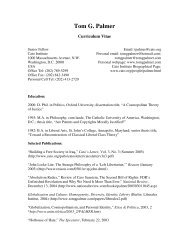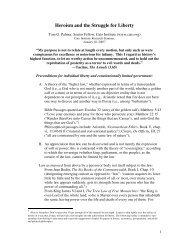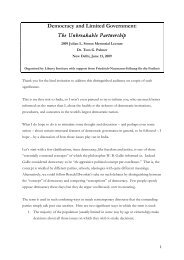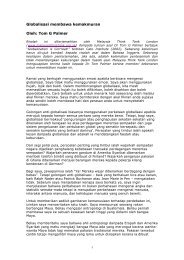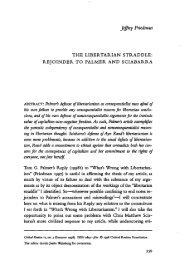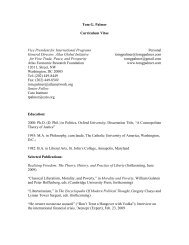Are Patents and Copyrights Morally Justified? - Tom G. Palmer
Are Patents and Copyrights Morally Justified? - Tom G. Palmer
Are Patents and Copyrights Morally Justified? - Tom G. Palmer
Create successful ePaper yourself
Turn your PDF publications into a flip-book with our unique Google optimized e-Paper software.
No. ~S] <strong>Are</strong> <strong>Patents</strong> <strong>and</strong> <strong>Copyrights</strong> <strong>Morally</strong>Jvst!fied? S49<br />
as necessary to the realization of freedom reduce, then, to the<br />
argument of Wilhelm von Humboldt, which, as noted above,’ 24<br />
is another version of the principal argument of John Locke.<br />
And this liberty-based argument, in its primary implications, is<br />
hostile rather than friendly to intellectual property claims, for<br />
such claims represent liberty-restrictions on others in ways that<br />
tangible property rights do not.<br />
As to the droite de suite, or inalienable resale royalty right, the<br />
economic consequences of this notion havebeen explored elsewhere.’<br />
25 It should suffice to point out that this resale royalty<br />
right benefits some established artists by awarding them<br />
unearned windfall profits, while others suffer by having their<br />
freedom to negotiate over the schedule.ofpayments coercively<br />
abridged. The prospect of having to part with a share of the<br />
appreciation of a work is capitalized into the sale price, meaning<br />
that the money received at the point of sale by the artist will<br />
be less.’ 26 In addition, like inalienable personal rights over art<br />
works, such “rights” reduce the moral agency of artists by restricting<br />
their rights to make contracts with others. The terms<br />
of the contract are fixed by others, <strong>and</strong> the contracting parties<br />
are constrained from freely transferring their property by<br />
contract.<br />
IV. THE BASIC STRUCTURE OF UTILITARIAN ARGUMENTS AND<br />
INTELLECTUAL PROPERTY RIGHTS<br />
As noted earlier, utilitarian arguments of a certain class can<br />
cut for or against intellectual property rights claims. As dealt<br />
with in much of the economics literature, for example, ‘the utility<br />
gains from increased incentives for innovation must be<br />
weighed against the utility losses incurred from monopolization<br />
of innovations <strong>and</strong> their diminished diffusion, Some have<br />
argued that the first part of the comparison may be either nega-<br />
matter; as I havenotedelsewhere, however, purelyutilitarian claims on behalfof intellectualproperty<br />
rights are shaky, at best. See <strong>Palmer</strong>, supra note 7.<br />
124. See supra notes 69-77 <strong>and</strong> accompanying text.<br />
125. See, e.g., Rottenberg, The Remuneration ofArtists, in FRONTIERS OF ECONOMICS 47-<br />
51 (K. Arrow & S. Honkapohja eds. 1985); Bolch, Damon, & Hinshaw, An Economic<br />
Analysis of the California Art Royalty Statute, 10 C0NN. L. REV. 689 (1978).<br />
126. Those who prefer paymentnow to payment later, such as the many artists who<br />
sell their work “on the street,” are harmed by such a requirement. As Ben W. Bolch<br />
remarks: “Many artists, ‘starving’or not, want their money now, not tomorrow. Otherwise,<br />
they would ‘invest’ in theart by keeping it for themselves.” Bolch, There Is NoJust<br />
Price For Art, N.Y. Times, Nov. 28, 1987, at 23, col. 4.



